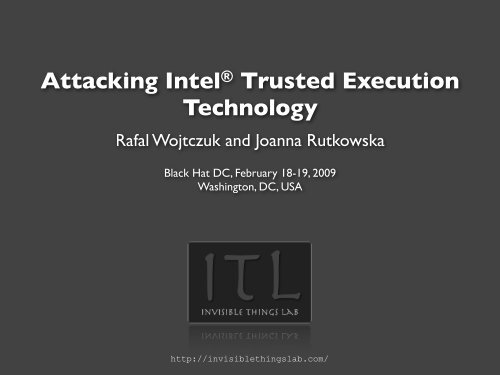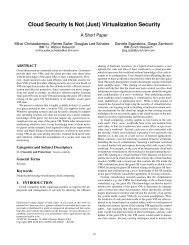Rafal Wojtczuk and Joanna Rutkowska - Black Hat
Rafal Wojtczuk and Joanna Rutkowska - Black Hat
Rafal Wojtczuk and Joanna Rutkowska - Black Hat
You also want an ePaper? Increase the reach of your titles
YUMPU automatically turns print PDFs into web optimized ePapers that Google loves.
Attacking Intel ® Trusted Execution<br />
Technology<br />
<strong>Rafal</strong> <strong>Wojtczuk</strong> <strong>and</strong> <strong>Joanna</strong> <strong>Rutkowska</strong><br />
<strong>Black</strong> <strong>Hat</strong> DC, February 18-19, 2009<br />
Washington, DC, USA<br />
http://invisiblethingslab.com/
1<br />
Trusted Execution Technology (TXT)<br />
2<br />
Attacking TXT<br />
3<br />
More on the Implementation Bugs<br />
4<br />
More on the TXT design problem
Intel ® Trusted Execution<br />
Technology (TXT)
Trusted Computing
TPM 1.2<br />
Passive I/O device (master-slave)<br />
Special Registers: PCR[0...23]<br />
Interesting Operations:<br />
Seal/Unseal,<br />
Quote (Remote Attestation)<br />
some crypto services, e.g. PRNG, RSA
PCR registers
PCR “extend” operation<br />
PCRN+1 = SHA-1 (PCRN + Value)<br />
A single PCR can be extended multiple times<br />
It is computationally infeasible to set PCR to a specified value<br />
(ext(A), ext(B)) ≠ (ext(B), ext(A))
TPM: Seal/Unseal Operation<br />
0x12345678abcdef01<br />
PCR 17<br />
secret (key)<br />
sealing<br />
0x22443dd937495955<br />
PCR 18<br />
TPM<br />
0xaaa9244ff3445574<br />
PCR 19<br />
secret (key)<br />
unsealing
TPM seal/unseal example<br />
# echo 'Secret!!!' | tpm_sealdata -z -i/proc/self/fd/0<br />
-o./mysecret.blob -p17 -p18 -p19<br />
// assuming PCR’s are the same<br />
# tpm_unsealdata ./mysecret.blob<br />
Secret!!!<br />
// assuming PCR’s are different<br />
# tpm_unsealdata ./mysecret.blob<br />
error 24: Tspi_Data_Unseal: 0x00000018 - layer=tpm,<br />
code=0018 (24), Wrong PCR value
TPM: Quote Operation (Remote Attestation)<br />
0x12345678abcdef01<br />
PCR 17<br />
0x22443dd937495955<br />
PCR 18<br />
TPM<br />
[PCR17,18,19] +<br />
signature (AIK)<br />
0xaaa9244ff3445574<br />
PCR 19
Both seal/unseal <strong>and</strong> quote operations can use any subset<br />
of PCR registers (e.g. PCR17, 18, 19)
Static Root of Trust Measurement (SRTM)
BIOS ROM BIOS FLASH BOOT LOADER OS kernel<br />
PCI<br />
ROMs<br />
PCR<br />
Usage (convention)<br />
0 BIOS ROM & FLASH<br />
1 Chipset config<br />
2 PCI ROMs<br />
3 PCI config<br />
4 bootloader<br />
5 bootloader config<br />
6 ...<br />
7 ...<br />
8 e.g. OS kernel<br />
PCR0<br />
PCR1<br />
PCR2<br />
PCR3<br />
PCR4<br />
...<br />
TPM
SRTM in practice
Example #1: Disk Encryption<br />
Disk encrypted with a key k, that is sealed into the TPM...<br />
Now, only if the correct software (VMM, OS) gets started it will<br />
get access to the key k <strong>and</strong> would be able to decrypt the disk!<br />
MS’s Bitlocker works this way.
But the key k must be present in the memory all the time...<br />
(the OS needs it to do disk on-the-fly decryption)
So, a malware can sniff it…
Two ways to solve it...
Example #2: User’s Picture Test :)<br />
During installation, a user takes a picture of themselves using a<br />
built-in in laptop camera...<br />
This picture is stored on disk, encrypted with key kpic, which is<br />
sealed by the TPM…<br />
Now, on each reboot — only if the correct software got<br />
loaded, it will be able to retrieve the key kpic <strong>and</strong> present a<br />
correct picture to the user.<br />
Important: after the use accepts the picture, the software should<br />
extend PCR’s with some value (e.g. 0x0), to lock access to the<br />
key kpic
Example #3: Remote Attestation<br />
Each computer needs to “authenticate” itself to the monitoring<br />
station using the TPM Quote comm<strong>and</strong>…<br />
If a computer is discovered in a corporate network that hasn’t<br />
authenticated using TPM Quote with expected PCR registers, an<br />
alarm should be raised (e.g. this computer should be disconnected from the corporate network).<br />
Convenient for corporate scenarios with centralized monitoring<br />
server.
Problems with SRTM
COMPLETENESS — we need to measure every possible piece<br />
of code that might have been executed since the system boot!<br />
SCALABILITY of the above!
Dynamic Root of Trust Measurement (DRTM)
Attempt to address the SRTM’s weaknesses —<br />
lack of scalability <strong>and</strong> the need for completeness...
A VMM we want to load<br />
(Currently unprotected)<br />
The VMM loaded <strong>and</strong> its<br />
hash stored in PCR18<br />
VMM<br />
SENTER<br />
VMM<br />
TPM<br />
PCR18<br />
secret key<br />
TPM will unseal<br />
secrets to the justloaded<br />
VMM only if it<br />
is The Trusted VMM<br />
Notes:<br />
Diagram is not in scale!<br />
SENTER also resets <strong>and</strong> extends PCR17 with hash of SINIT/BIOSACM/(STM)/ LCP
SENTER — one of a few new instructions introduced by TXT<br />
(They are all called SMX extensions)
TXT bottom line<br />
TXT late launch can transfer from unknown/untrusted/<br />
unmeasured system…<br />
to a known/trusted/measured system<br />
Without reboot!<br />
The system state ("trustedness") can be verified (possibly<br />
remotely) because all important components (hypervisor,<br />
kernel) hashes get stored into the TPM by SENTER.
TXT implementation: tboot
GRUB (1 st stage)<br />
GRUB (2 nd stage)<br />
SENTER resets PCR18 <strong>and</strong><br />
extends it with a hash of<br />
tboot’s MLE<br />
tboot (“1 st stage”)<br />
tboot MLE<br />
xen.gz<br />
Disk<br />
Notes:<br />
Diagram is not in scale!<br />
SENTER also resets <strong>and</strong> extends PCR17 with hash of SINIT/BIOSACM/(STM)/ LCP
Xen + tboot example
First we start “trusted” Xen (built by root@)<br />
...<strong>and</strong> seal some secret to PCR17/18/19
Now we boot “untrusted” Xen (compiled by hacker@)...
Thanks to tboot only when the trusted xen.gz was booted we can<br />
get the secret unsealed from the TPM!
Now some live demos...
Tboot Demo #1: sealing to a trusted Xen
Tboot Demo #2: booting an untrusted Xen
SENTER is not obligatory!!!<br />
TXT <strong>and</strong> TPM: cannot enforce anything on our hardware! We can always choose not to execute SENTER!
So what is this all for?
Why would a user or an attacker be<br />
interested in executing the SENTER after all?
It’s all about TPM PCRs <strong>and</strong> secrets sealed in TPM! — see previous<br />
SRTM examples — it’s all the same with DRTM<br />
(alternatively: about Remote Attestation)
AMD Presidio<br />
AMD’s technology similar to Intel’s TXT, part of AMD-V<br />
A special new instruction SKINIT (Similar to Intel’s SENTER)<br />
We haven’t looked at Presidio thoroughly yet.
Launch time protection vs. runtime protection
SRTM/DRTM<br />
(launch-time protection)<br />
e.g. buffer overflow<br />
(no runtime protection!)<br />
MBR/<br />
BIOS<br />
hypervisor<br />
VM1 VM2 VM3<br />
Management<br />
Domain
Theoretically runtime-protection should be implemented<br />
effectively using the VT-x/ VT-d technologies...<br />
In practice: see our “Xen Owning Trilogy”<br />
(BH USA 2008) ;)
TXT: exciting new technology with great potential!<br />
(Eg. whenever a user boots their machine he or she knows it is secure!)
Attacking TXT
Q: What is more privileged than a kernel code?<br />
A: Hypervisor (“Ring -1”)
Q: What is more privileged than a hypervisor?<br />
A: System Management Mode (SMM)
Introducing “Ring -2”<br />
SMM can access the whole system memory (including the<br />
kernel <strong>and</strong> hypervisor memory!!!)<br />
SMM Interrupt, SMI, can preempt the hypervisor (at least<br />
on Intel VT-x)<br />
SMM can access the I/O devices (IN/OUT, MMIO)
Q: Is this SMM some new thing?<br />
A: Nope, it’s there since 80386...
SMM vs. TXT?
SMM gets loaded before Late Launch...
Q: Does TXT measure currently used SMM?<br />
A: No, TXT doesn’t measure currently loaded SMM
Q: Does TXT reload SMM on SENTER execution?<br />
A: No, SENTER doesn’t reload SMM…<br />
(SENTER does not touch currently running SMM at all!)
Q:So, how does the SENTER deal with a malicious SMM?<br />
A:Well… it currently does not!
Oh...
TXT attack sketch (using tboot+Xen as example)<br />
GRUB (1 st stage)<br />
GRUB (2 nd stage)<br />
Attacker patches the<br />
bootloader (e.g. GRUB). The<br />
patched code injects a<br />
shellcode to SMM<br />
Evil shellcode will infect the<br />
Xen hypervisor later...<br />
tboot.gz<br />
xen.gz<br />
SMRAM<br />
After xen.gz gets sucesfully<br />
loaded, the evil code from<br />
SMRAM can easily infect it...<br />
Disk<br />
Notes:<br />
Diagram is not in scale!<br />
SENTER also resets <strong>and</strong> extends PCR17 with hash of SINIT/BIOSACM/(STM)/ LCP
Let’s have a look at the actual SMM shellcode
Address of the shellcode (in<br />
the guest address space)<br />
Address of an unused entry in<br />
the hypercall_table
... <strong>and</strong> the shorter version...
The final outcome...
Wait! But how to infect the SMM h<strong>and</strong>ler?
Stay tuned!<br />
SMM exploiting to be presented in the next chapter...
Let’s take a look at the live demo now...
More on the Implementation Bugs
So how we can get into SMM memory (SMRAM)?
SMM research quick history
2006: Loic Duflot<br />
(not an attack against SMM, SMM unprotected < 2006)<br />
2008: Sherri Sparks, Shawn Embleton<br />
(SMM rooktis, but not attacks on SMM!)<br />
2008: Invisible Things Lab (Memory Remapping bug in Q35 BIOS)<br />
2009: Invisible Things Lab (CERT VU#127284, TBA)<br />
(checked box means new SMM attack presented; unchecked means no attack on SMM presented)
No SMM bugs<br />
known...<br />
...cannot read<br />
SMM memory<br />
(TSEG)...<br />
...cannot look for<br />
bugs in TSEG!<br />
Oopsss…. A vicious circle!
So, how did we get around this vicious circle?
De-soldering?
Meet Atmel 26DF321 SPI-flash
De-soldered SPI-flash chip
Looks promising, but...
The BIOS image on the SPI-flash is heavily packed!<br />
(inconvenient form for SMM auditing)
So, we used a different approach…<br />
(but we wanted to show the “pics from the lab” anyway;)
Remember our Q35 bug from Vegas?<br />
(We couldn’t actually present it during the conference as there was no patch then, but we published the slides a<br />
few weeks afterwards)
Memory Remapping on Q35 chipset<br />
TOUUD<br />
5GB<br />
REMAPLIMIT<br />
remapping<br />
REMAPBASE<br />
4GB<br />
TOLUD<br />
MMIO<br />
This DRAM now accessible from<br />
CPU at physical addresses:<br />
<br />
Otherwise would be wasted!<br />
Processor’s View<br />
DRAM
Now, applying this to SMM...
#define TSEG_BASE 0x7e500000<br />
u64 target_phys_area = TSEG_BASE & ~(0x10000-1);<br />
u64 target_phys_area_off = TSEG_BASE & (0x10000-1);<br />
new_remap_base = 0x40;<br />
new_remap_limit = 0x60;<br />
reclaim_base = (u64)new_remap_base
We see we can access SMM memory using this Q35 bug :)
Intel patched the bug in August 2008<br />
(This was done by patching the BIOS code to properly lock the memory configuration registers)
So, what now?
VU#127284
December 2008:<br />
Intel<br />
We think TXT is essentially useless without<br />
protection against SMM-originating<br />
attacks...<br />
That’s an exaggerated statement - we still<br />
believe infecting an SMM is hard...<br />
BTW, we just found a bunch of new SMM<br />
bugs for Intel BIOSes + 2 working<br />
exploits ;)<br />
Invisible Things Lab<br />
The dialogs between ITL <strong>and</strong> Intel presented here have been modified for brevity <strong>and</strong> for better dramatic effect.
We have provided Intel with the details of the new SMM issues<br />
affecting their recent BIOSes on December 10 th , 2008.
Intel confirmed the problems in their BIOSes as affecting:<br />
“mobile, desktop, <strong>and</strong> server motherboards", without providing any more<br />
details about which exact models are vulnerable.
We suspect it might affect all recent Intel motherboards/BIOSes.
Intel believes the issues might affect other vendors as well...
Intel contacted CERT CC informing them about the problem...
CERT has assigned the following tracking # to this issue:<br />
VU#127284
We plan to discuss the details of the bugs at BH USA 2009 in Vegas...
Stay tuned!<br />
(<strong>and</strong> don’t trust your SMM in the meantime)
More on the TXT Design Problem
Intel<br />
Solution to the TXT attack is called: STM<br />
Can we take a look at this STM?<br />
STM is currently not available.<br />
?<br />
It is simple to write. There was just no<br />
market dem<strong>and</strong> yet.<br />
?<br />
Invisible Things Lab<br />
The dialogs between ITL <strong>and</strong> Intel presented here have been modified for brevity <strong>and</strong> for better dramatic effect.
SMM Transfer Monitor (STM)<br />
Communication<br />
protocol<br />
hypervisor (VMM)<br />
STM<br />
SMI<br />
VM1 VM2 SMM
Potential issues with STM<br />
STM seems to be non-trivial to write!<br />
CPU, memory <strong>and</strong> I/O virtualization for the SMM need to be implemented!<br />
VMM-to-STM protocol asks for a st<strong>and</strong>ard<br />
No STM in existence as of yet…<br />
also...
Intel<br />
Who should write an STM?<br />
OEMs/BIOS vendors!<br />
Hmm… Isn’t Intel a BIOS vendor itself?<br />
Invisible Things Lab<br />
The dialogs between ITL <strong>and</strong> Intel presented here have been modified for brevity <strong>and</strong> for better dramatic effect.
Intel<br />
Why should we trust BIOS vendors to<br />
write bug-free STMs, if we don’t trust they<br />
will write bug-free SMMs?<br />
SMM must be “tuned” to each new<br />
motherboard. STM could be written in a<br />
generic way — no need to change STM<br />
after it gets mature.<br />
Fair point.<br />
Invisible Things Lab<br />
The dialogs between ITL <strong>and</strong> Intel presented here have been modified for brevity <strong>and</strong> for better dramatic effect.
Intel told us they do have STM specification that answers some of<br />
our concerns (e.g. that STM is difficult to write), <strong>and</strong> the spec is<br />
available under NDA.
Intel offered us a chance to read the STM spec…<br />
...but required signing an NDA.<br />
…<br />
We refused.<br />
(We’d rather not tie our h<strong>and</strong>s with signing an NDA — we prefer to wait for some STM to be available <strong>and</strong> see if we can break it :)
Intel might be right claiming that STM is the remedy for our attack.
There are some other issues with STM however…<br />
e.g. how the STM will integrate with the SENTER measurement<br />
process?
We cannot make our mind on this until we see a working STM.<br />
…<br />
Stay tuned! And cross your fingers!<br />
…<br />
If you are interested in sponsoring this research further, do not<br />
hesitate to contact us!
Still, allowing TXT to work without an STM was, in our opinion, a<br />
design error.
Summary
Intel TXT is a new exciting technology! It really is!<br />
Intel “forgot” about one small detail: SMM…<br />
We found <strong>and</strong> demonstrated breaking into SMM,<br />
this allowed us to also bypass TXT.<br />
Bonus: SMM rootkits now possible on modern systems!<br />
Intel currently is patching the SMM bugs (BIOS),<br />
We hope our presentation will stimulate Intel <strong>and</strong> OEMs to<br />
create <strong>and</strong> distribute STMs — a solution to our attacks<br />
against TXT.
http://invisiblethingslab.com





